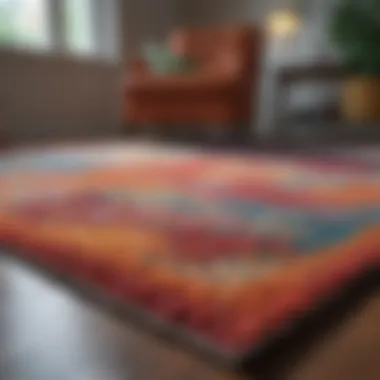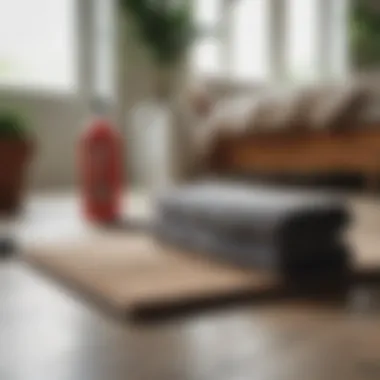Comprehensive Guide to Shampooing Area Rugs


Intro
Maintaining area rugs is vital not just for aesthetics, but also for the longevity of these possessions. Often, rugs are subjected to daily wear and tear. They can collect dust, allergens, stains, and odors. Proper cleaning techniques can help rejuvenate and preserve their appearance. This guide will delve deep into shampooing area rugs, covering the necessary preparations, specific cleaning methods, and important post-cleaning care.
Rugs come in various materials, each requiring unique attention and care. Additionally, the choice of cleaning agents and tools can significantly affect cleaning outcomes. To achieve optimal results, understanding these aspects is essential. Throughout this article, we will provide insights on selecting the right approach based on the rug material. This will empower homeowners, architects, and design enthusiasts to adopt informed practices in rug maintenance.
By breaking down each step of the shampooing process, we hope to enhance readers' understanding and ability to tackle common challenges associated with rug cleaning.
Featured Homes
Architectural Styles
In areas where rugs make a statement, the architectural styling often plays a crucial role. Homes with open spaces may benefit from vibrant, large area rugs that add warmth and define spaces. In contrast, minimalist designs typically favor more subdued patterns. Understanding the relationship between the home’s architecture and the choice of area rugs can lead to better design decisions.
- Modern Home: Clean lines, neutral colors, and functionality. Rugs here may focus on geometric patterns.
- Traditional Home: Rich colors and intricate designs are often used, reflecting historical influences.
- Bohemian Style: Eclectic mix of colors and patterns, with rugs complementing layered decor elements.
These choices influence not only the look, but also how often rugs require cleaning. Rugs in high-traffic areas tend to get dirtier faster compared to those in more protected corners of the home.
Unique Design Elements
Unique design elements can elevate the role of area rugs in home decor. For instance, a well-placed rug can serve to unify disparate design themes within a space. Rugs created from natural fibers like jute or wool often add texture and warmth. In contrast, synthetic materials may be more resistant to stains and easier to maintain.
The size and placement of rugs are significant as well. Larger rugs can create a sense of cohesion, while smaller accent rugs can bring in color or pattern without overwhelming a space. When selecting a rug, consider what materials and styles will complement your home's unique design features.
"The right area rug not only enhances the aesthetic but also protects flooring and provides comfort."
Culmination
By integrating practical insights into the cleaning and maintenance of area rugs, you not only enhance the overall appearance of your home but also invest in the longevity of these valuable decor pieces. Understanding the context in which rugs exist—be it the architectural style of a home or the unique design elements present—will inform your choices on care and maintenance. Stay tuned as we explore the specific processes involved in shampooing area rugs effectively.
Understanding Area Rugs
Understanding area rugs is crucial for any homeowner or design enthusiast. They not only serve a functional purpose, such as adding warmth and comfort underfoot, but they also enhance the aesthetics of a space. The choice of area rug can influence the overall ambiance of a room, complementing furniture and decor effectively.
Defining Area Rugs
Area rugs are decorative textiles that cover a section of floor space. Unlike wall-to-wall carpeting, area rugs are not fixed and can be moved or replaced easily. They come in various shapes, sizes, and materials. Typically, area rugs can range from small accent pieces to large central designs that anchor a room. The versatility in design allows them to fit various style preferences, from modern to traditional.
Common Types of Area Rugs
There are several common types of area rugs, each made from different materials and methods of construction:
- Wool Rugs: Known for their durability and natural insulating properties. They are soft yet resilient, making them a popular choice for living spaces.
- Synthetic Rugs: Often made from materials like polypropylene or nylon. They tend to be more affordable and are resistant to stains and wear.
- Silk Rugs: Luxurious and often used in formal settings. These rugs require more maintenance but feature intricate patterns and colors.
- Cotton Rugs: Lightweight and easy to clean. Cotton rugs are great for casual settings and can be machine-washed.
- Jute and Sisal Rugs: Made from natural fibers, they offer an organic look and are very sturdy, often used in high-traffic areas.
Benefits of Area Rugs
Area rugs provide multiple benefits beyond just aesthetic appeal:
- Sound Absorption: They help absorb sound in a room, making it quieter and more comfortable.
- Insulation: They provide warmth, especially in colder months, contributing to energy efficiency.
- Defining Spaces: Rugs can help in delineating areas in open floor plans, creating cozy spots without permanent partitions.
- Style Enhancement: The right rug can pull together various design elements, enhancing the overall theme.
Area rugs are not just decorative; they are an investment in comfort and design.
Assessing the Need for Shampooing


Before jumping into the intricacies of shampooing area rugs, it is critical to assess whether your rug indeed requires such a thorough cleaning. This analysis plays a pivotal role in determining the right approach, saving time and resources. Understanding the state of your rug lays the groundwork for establishing a regular maintenance schedule and prolonging its lifespan. The benefits of assessing the need for shampooing cannot be overstated: it allows you to target specific spots, avoid unnecessary wear during cleaning, and choose the proper cleaning method.
Identifying Dirt and Stains
Identifying dirt and stains on an area rug is not merely an aesthetic concern; it is an integral aspect of maintaining its integrity. Daily foot traffic, pet activities, and other environmental factors contribute to the accumulation of dirt. Regular checks can help pinpoint high-traffic areas that may require immediate attention. Stains may be obvious, but some could be embedded deep in the fibers, necessitating a keen eye for detection.
To assess effectively, kneel down and inspect the rug closely. Look for discolorations, unusual textures, or anything that might disrupt the uniform appearance of the material. Different cleaning solutions are designed for varying types of stains, such as oil-based or protein-based. Thus, recognizing the type of dirt present is essential for selecting an appropriate cleaning agent later on.
Frequency of Cleaning
The frequency of cleaning area rugs will depend on several factors, including their location, usage, and material. For instance, rugs located in high-traffic areas of the home, like hallways and living rooms, may need more frequent shampooing compared to those in less frequented spaces. As a general guideline, vacuuming should occur weekly, while deeper cleaning should be considered every six months to a year.
Environmental elements matter as well. If you live in an area with high levels of dust or pollen, more frequent shampooing may be necessary. Moreover, households with pets or children should also adopt a more rigorous cleaning schedule due to increased likelihood of spills and stains. Establishing an appropriate rhythm aligned to your unique circumstances helps maintain the rug's condition effectively.
Signs of Wear and Tear
Recognizing the signs of wear and tear is another significant element in deciding when to shampoo. Over time, area rugs can exhibit fraying edges, fading colors, or a loss of texture. These indicators suggest that the rug might be absorbing dirt and stains more easily, necessitating a thorough clean. Pay attention to areas where foot traffic is heavy. If you feel the fibers have become flattened or matted, that is a good sign that your rug needs more than just vacuuming.
Additionally, be vigilant about odors that could emanate from the rug, as these may indicate trapped dirt or even mold. If your area rug shows any of the aforementioned signs, it might be time to engage in a shampooing process to restore its original luster and freshness.
"A proactive approach to assessing your area rug's condition can prevent extensive damage and ultimately save money on replacements or professional services."
By carefully identifying dirt, establishing a cleaning frequency, and remaining vigilant about signs of deterioration, one can make informed choices regarding shampooing area rugs. This evaluation not only enhances the rug's visual appeal but also contributes to a healthier living environment.
Preparation for Shampooing
Preparation is a critical phase in the shampooing process for area rugs. Subpar preparatory steps can undermine all efforts made in the subsequent cleaning stages. The quality of the final result highly relies on how well one prepares for the task ahead. By carefully gathering supplies, selecting the right cleaning solutions, and conducting tests on those solutions, one can ensure a more effective cleaning process.
Gathering Necessary Supplies
To begin, having the correct supplies at hand is essential. This includes basic tools and specialized products that facilitate an efficient cleaning session.
- Vacuum Cleaner: A reliable vacuum is needed to remove loose dirt and debris. A vacuum with a beater bar can be particularly effective for rugs with a higher pile.
- Shampoo: The chosen shampoo should be compatible with the material of the rug. For instance, wool rugs require specific wool-safe shampoos.
- Brushes: Soft-bristle brushes help distribute the shampoo evenly without damaging the fibers of the rug.
- Buckets: A clean bucket will be needed for mixing the solution, if necessary.
- Towels: Absorbent towels are useful for soaking up excess water.
These supplies form the basic toolkit for effectively shampooing area rugs.
Choosing the Right Cleaning Solution
Selecting the appropriate cleaning solution is essential for both the rug's longevity and cleaning success. There are numerous options available in the market today, and this variety necessitates careful consideration. It is vital to check the fiber type of the rug before proceeding.
- For Synthetic Rugs: Non-toxic and mild shampoos work best. Avoid harsh chemicals that can lead to fading or discoloration.
- For Natural Fibers: Opt for specialized cleansers specifically designed for wool, cotton, or silk. These products often contain natural ingredients that clean without harming the fibers.
- Eco-Friendly Options: Consider cleaning solutions with biodegradable properties. They provide less environmental impact while still effectively cleaning.
Testing the Cleaning Solution
Before applying the cleaning solution to the entire rug, it is wise to conduct a test in a less visible area. This step can help to identify any adverse reactions that could potentially damage the rug. To perform the test:
- Prepare a Small Amount: Mix a small, diluted amount of the cleaning solution with water as per the product's instructions.
- Apply to a Small Area: Use a cotton swab or soft cloth to apply the solution to a hidden section of the rug. This ensures that the effectiveness of the cleansing agent is verified without risk.
- Monitor the Results: Wait for a few minutes to observe for any unacceptable changes, such as color bleeding or damage to the fibers.
By adequately preparing for the shampooing process, one can significantly enhance the chances of achieving a satisfying cleaning result. The attention paid to each preparatory step contributes to the overall quality of care that area rugs receive, safeguarding their beauty over time.
The Shampooing Process
The shampooing process is a critical step within the overall maintenance of area rugs. It not only helps in preserving their visual appeal but also contributes to prolonging their lifespan. Effective shampooing removes dirt, allergens, and odors, ensuring a fresh environment in your living space. Understanding the nuances of this process is essential, as it helps to avoid common pitfalls that can lead to schade.


Vacuuming the Rug
Vacuuming is the preliminary step in the shampooing process and should not be underestimated. It serves as the foundation for the cleaning procedure. By removing loose dirt and debris, you prepare the rug for a deeper clean.
- Use a vacuum cleaner with a beater bar for effective dirt lift.
- Pay extra attention to fringes and corners, where dirt accumulates often.
- Vacuum both sides of the rug, if possible.
This removes not only visible particles but also irritants that could become embedded during the shampooing process, leading to ineffective cleaning.
Applying the Shampoo
Once vacuuming is complete, applying the shampoo correctly is crucial. Choosing the right cleaning solution based on the material of the rug is essential to avoid damage.
- Mix the shampoo with water according to the manufacturer’s instructions.
- Use a sponge or spray bottle to apply. Avoid soaking the rug excessively as too much water can lead to mold growth.
- Work from one end of the rug to the other to ensure even coverage.
The key here is to agitate just enough to lift the dirt without damaging the fibers.
Brushing Techniques
Brushing the rug after applying the shampoo plays an important role in thorough cleaning. It helps to agitate the fibers and allows the cleaning solution to penetrate effectively.
- Use a brush with soft bristles to avoid damaging the rug.
- Brush in the direction of the fibers to avoid causing frizz.
- Divide the rug into sections to ensure that each part receives equal attention.
Proper brushing not only aids in cleaning but enhances the overall texture of the rug.
Rinsing the Rug
The final step in the shampooing process is rinsing, which needs care and attention. This step ensures that all cleaning agents are removed and that the rug is left clean and odor-free.
- Use a wet-dry vacuum or a hose to rinse the rug carefully.
- Make sure to use clean water and avoid oversaturating the rug.
- Rinse until the water runs clear; any leftover shampoo can attract dirt in the future.
Overall, the shampooing process is a sequence of interconnected steps, each requiring attention to detail. When executed correctly, it returns the rug to its former beauty, maintaining the integrity of its fibers and colors.
Post-Cleaning Care
Post-cleaning care is a vital component of shampooing area rugs. Completing the cleaning process does not end the maintenance; instead, it sets the stage for the longevity and aesthetics of the rug. Proper post-cleaning techniques can significantly influence both the immediate appearance of the rug and its long-term durability. Consider these key elements:
- Drying the Rug: Ensuring that the rug dries properly is essential. Excess moisture can lead to mold growth, which can damage fibers and emit unpleasant odors. Use fans or open windows to promote airflow and speed up the drying process. Avoid direct sunlight for natural fibers, as it may cause fading of colors.
- Bringing Back the Shape: Area rugs can lose their form through cleaning processes. Carefully reshaping the rug while it is still damp helps restore its original dimensions. Lay it flat and gently pull the corners to their right position. Weigh down the edges with books or heavy objects to maintain shape as it dries.
- Dealing with Odors: After a thorough cleaning, sometimes lingering odors may persist. It is crucial to address this issue promptly. Consider using natural deodorizers, such as baking soda or vinegar, which can help eliminate unwanted smells without harsh chemicals. Sprinkle baking soda on the rug, let it sit for several hours, and then vacuum it thoroughly to remove both the powder and any absorbed odors.
Regular post-cleaning maintenance not only enhances the lifespan of the rug but also ensures it remains a vibrant centerpiece in your home.
Finding effective ways to take care of your rug after shampooing aids in maintaining its beauty and usability. Following these post-cleaning practices will ensure that your area rugs continue to look fresh and inviting.
Long-Term Rug Maintenance
Maintaining area rugs is not just an act of cleaning; it embodies the commitment to preserving their texture, color, and overall condition over time. Proper long-term maintenance substantially increases the lifespan of the rugs, making them a durable investment for any home. In this section, we will explore key strategies for long-term rug maintenance, including regular vacuuming, the use of rug guards, and scheduling professional cleaning.
Regular Vacuuming Practices
Vacuuming serves as the backbone of any rug maintenance routine. By regularly removing dirt and debris, vacuuming can prevent particles from embedding themselves into the fibers, which may cause damage over time. Aim to vacuum your area rugs at least once a week, or more frequently in high-traffic areas. Pay special attention to the following:
- Choose a vacuum cleaner that has a gentle setting to avoid damaging delicate fibers.
- Use a vacuum nozzle designed for carpets to ensure effective cleaning.
- Avoid vacuuming fringes or tassels directly to prevent snagging.
Regular vacuuming not only removes dirt but can also revive a rug's appearance. It helps to keep the colors vibrant and minimizes the need for deep cleaning. To enhance this routine, consider combining vacuuming with occasional spot cleaning to address stains before they set in.


Using Rugs Guards
Rug guards are an important investment, especially for those with area rugs in high-traffic zones. These protective pads serve multiple purposes:
- Prevent Slipping: Rugs guards help keep the rugs in place, reducing the risk of accidents.
- Added Padding: They provide cushioning underfoot, enhancing comfort.
- Protection from Wear: Guards can extend the life of your rugs by absorbing impact and preventing friction between the rug and the floor surface.
When selecting a rug guard, ensure it is appropriate for both the type of rug and the flooring underneath. For instance, a non-slip pad works best on hardwood, while thicker, cushioned pads may be suitable for carpets.
Schedule for Professional Cleaning
Even with a diligent maintenance routine, area rugs need professional cleaning from time to time. Depending on the usage and the type of rug, consider scheduling a professional cleaning every 1 to 2 years. Here are a few points to contemplate when determining the frequency:
- Material: Different materials can require varying approaches. For example, silk or wool rugs may need more careful handling than synthetic ones.
- Traffic: Rugs in high traffic areas will accumulate dirt faster and may need professional cleaning more often.
- Allergies: If users suffer from allergies, regular professional cleaning can help reduce dust and other allergens trapped deep within the fibers.
"Regular cleaning by professionals not only refreshes the look of the rugs but also can be vital for retaining both value and appeal."
Challenges in Shampooing Area Rugs
Shampooing area rugs can be a beneficial practice for maintaining their appearance and extending their lifespan. However, this process comes with its own set of challenges that need to be understood and addressed. Recognizing these challenges can help homeowners and cleaning professionals preserve the beauty and durability of their rugs.
Handling Delicate Fabrics
When working with delicate fabrics such as silk or fine wool, it is crucial to handle them with care. Delicate fibers can be easily damaged by harsh cleaning agents or intense scrubbing. Therefore, thorough research on the specific fabric type is required before choosing a cleaning solution. Using less water and opting for gentle cleaning methods is advisable, as too much moisture can lead to warping or color bleeding.
Additionally, consider testing any product in an inconspicuous area before full application. This precaution safeguards the integrity of the fabric and ensures that the desired outcome is achieved without causing damage.
Enzyme-Based Stains
Enzyme-based stains, such as those from food, urine, or other organic materials, pose unique challenges during the shampooing process. These stains can sometimes be complex to remove and may require specialized cleaning solutions that target the specific enzyme causing discoloration. Conventional shampoos often fail against those stains, simply spreading the residue around rather than lifting it.
It is essential to act quickly when dealing with enzyme stains to prevent them from setting in. As a best practice, applying an enzymatic cleaner promptly after the stain occurs can yield the best results. Carefully following the manufacturer's instructions will also contribute to effective stain removal, preserving the rug's original condition.
Allergies and Sensitivities
Many cleaning substances release chemicals that may irritate sensitive individuals, especially those with allergies. This presents a potential challenge during the shampooing process. To accommodate these concerns, using hypoallergenic or eco-friendly cleaning agents can be beneficial. These alternatives often lack harsh fragrances, dyes, and irritants found in traditional cleaners.
Moreover, before starting the shampooing process, ensure proper ventilation. Open windows and doors to allow fresh air circulation and minimize the risk of allergic reactions. This approach not only enhances safety but also contributes to a healthier living environment.
Choosing the right cleaning solutions and methods is pivotal for effective rug shampooing while addressing unique challenges.
Finale
Understanding the proper care and maintenance of area rugs is vital for keeping their aesthetic integrity and prolonging their lifespan. This guide offers a thorough examination of the shampooing process, including preparation, execution, and follow-up care. By following this detailed methodology, homeowners, designers, and enthusiasts can make informed decisions relating to rug care. Effective shampooing not only enhances the appearance of rugs but also contributes to a healthier indoor environment by removing allergens and dust.
The conclusion of this article underscores several key aspects. Firstly, maintaining cleanliness greatly affects the longevity of area rugs. Regular shampooing can prevent the buildup of dirt and stains. Secondly, choosing the right cleaning solutions tailored to the specific material can protect the fabric while ensuring effective dirt removal.
Moreover, knowing the unique challenges associated with various rugs, such as delicate fabrics and specific stains, prepares individuals to handle these circumstances effectively. An informed approach to rug care allows for the preservation of the unique qualities of each rug. In summary, implementing these strategies fosters a sustainable environment, offering both beauty and functionality in living spaces.
Summary of Key Points
- Regular shampooing is essential for maintaining the aesthetic appeal of area rugs.
- Appropriate cleaning agents tailored to rug materials maximize cleaning efficiency and safeguard the fabric.
- Understanding the unique needs and challenges of different rug types informs better maintenance practices.
- Post-cleaning care, including proper drying and reshaping, enhances longevity and appearance.
"A well-cared-for rug can serve as a centerpiece, significantly contributing to the overall design of a space."
Final Thoughts on Rug Care
Caring for area rugs is not just about hygiene; it’s about respecting the investment that such items represent in your home. Rugs can add warmth, character, and elegance to interiors. However, without maintenance, their charm could fade over time.
It is crucial to develop a dedicated routine for rug cleaning. By combining regular vacuuming with periodic shampooing, one ensures that rugs retain their vibrancy. Routine inspections for signs of wear are equally important, as early intervention can prevent more extensive damage.
Invest in high-quality cleaning supplies specifically designed for area rugs. They can make a significant difference in maintenance efforts. Furthermore, understanding the relationship between environmental factors and rug care can equip homeowners with the knowledge to adapt their cleaning schedules appropriately.















